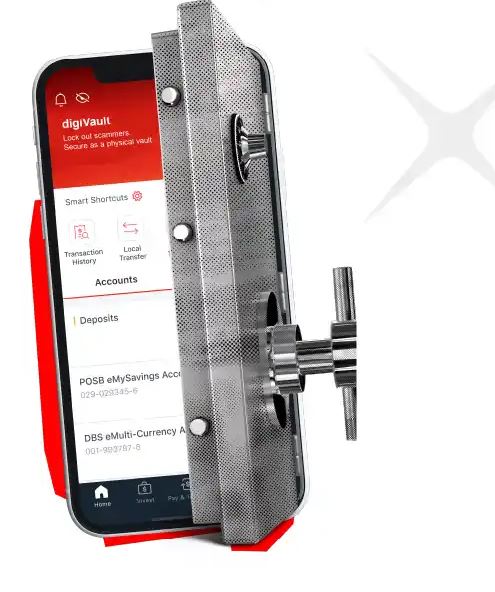
Digital scams have advanced dramatically in the last year, frequently evading fundamental safeguards and taking advantage of gullible customers through social engineering. DBS responded by launching digiVault, a feature that lets users “lock” their money, turning regular bank accounts into something remarkably akin to a virtual stronghold.
DBS has created a particularly novel solution by providing an additional layer of self-managed protection. Customers can use Money Lock, as it is commonly known, to secure a portion of their funds so that digital transfers are not possible until they are physically verified at an ATM or branch. This incredibly successful method tackles one of the most prevalent scam techniques: remote manipulation via malicious software or phone calls.
Key Features of DBS Money Lock (digiVault)
| Feature | Details |
|---|---|
| Service Name | digiVault (Money Lock) |
| Provider | DBS / POSB |
| Primary Purpose | Lock funds to prevent digital theft |
| Activation Method | Via DBS digibank app or digibot |
| Access to Locked Funds | In-person at branches or select ATMs |
| Eligible Accounts | Existing savings, current, and fixed deposit accounts |
| Interest | Locked funds continue to earn interest |
| Unlocking Hours (for some types) | 8 AM – 8 PM daily |
| Service Fee | No additional charges |
| Security Benefit | Exceptionally clear barrier against unauthorized digital access |
Scam cases increased during the pandemic as remote access became commonplace and digital payments increased. Within minutes, victims claimed to have lost their entire life savings. In light of this, the concept of securing funds behind a barrier of biometric and in-person verification feels more like a lifeline than a burden. DigiVault has helped many people feel more at ease, including elderly customers who have been the target of phishing scams.
Clients have the option of creating a brand-new digiVault account or locking money in their existing accounts or fixed deposits. By incorporating these choices, DBS greatly increased the system’s adaptability. Users can continue to earn interest, frequently at the same rates they have in the past, while managing protection levels according to their needs. For example, without sacrificing their ability to grow financially, a parent saving for a child’s tuition may lock those funds to prevent unintentional or fraudulent transfers.
The procedure itself is very effective. Customers can activate Money Lock with a few taps by using DBS’s digibank app. The funds are digitally immobile after an email confirming the lock is sent. One needs to show up in person with the appropriate identification in order to access them. It’s a decision that permits flexibility while drastically lowering risk.
Longtime DBS customer and self-described scam-awareness activist Florence Ang described how digiVault prevented her from facing financial ruin. She was reassured that her emergency savings were safely locked when she checked her app after getting a suspicious call from someone posing as bank representatives. She claimed that the peace of mind was invaluable.
However, some users have expressed worries. Discussions have been heated on sites like Reddit. When compared to alternatives like OCBC’s Money Lock, which permits ATM unlocking and provides better returns, critics contend that digiVault’s interest rates are excessively low. For others, the requirement to fully unlock the digiVault account instead of permitting partial access is inconvenient.
The security advantages are indisputable in spite of the criticisms. DBS has provided a timely and incredibly comforting solution by fortifying itself against digital fraud. Since its debut, digiVault has been used by over a million customers; the bank hopes to double that figure by further improving features and increasing educational outreach.
Additionally, DBS has increased its public involvement. By means of strategic collaborations with Singapore’s Cyber Security Agency, the bank introduced anti-scam tests aimed at enhancing digital literacy. 82% of respondents to one such survey said they felt more comfortable using online banking. By extending these programs to more than 30,000 citizens, DBS is creating a more intelligent financial community rather than merely protecting accounts.
In the meantime, money-locking tools have been introduced by UOB and OCBC. Similar safeguards are provided by UOB’s LockAway, which only permits in-branch visits and does not currently support ATMs. The flexibility of OCBC’s version is noteworthy; users can lock particular amounts while still using a card and PIN to access money via an ATM.
DBS’s digiVault is in the middle of these, striking a balance between convenience and security. But the wider range of tools that surround it is what really sets it apart. While Security Checkup offers a checklist to audit personal settings, Payment Controls enables users to immediately disable contactless payments. When combined, these tools create a security ecosystem that is significantly better than conventional products.
Financial institutions will continue to balance security and usability in the years to come. DBS has been very clear about its position: empower customers without sacrificing their savings. The bank encourages customers to bank mindfully in addition to digitally with features like digiVault.
Money Lock is a silent but effective safety net for parents saving for their children’s future, independent contractors accumulating emergency funds, and retirees seeking security. Although no system is flawless, this one conveys an important message: your money should be protected in a way that is both personal and intelligent.
